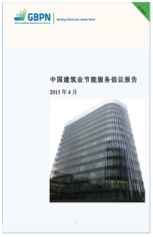ESCO models for the retrofit of existing buildings in China
GBPN conducted a study on the factors affecting the use of ESCO models for the retrofit of existing buildings in China, identifying current barriers to the development of the Chinese ESCO market, while also researching best-practice examples of ESCOs globally and investigating the feasibility of introducing those examples to China.

The global building sector accounts for approximately 30% of total energy consumption and CO2 emissions, which translates into approximately 10 billion tonnes of direct and indirect CO2 emissions using CO2 emissions data from in 2011. Given this impact, “green building” and energy efficiency renovation strategies of the 12th 5-year plan plays a key role in supporting the Chinese transition to a low carbon economy.
GBPN conducted a study on the factors affecting the use of ESCO models for the retrofit of existing buildings in China, identifying current barriers to the development of the Chinese ESCO market, while also researching best-practice examples of ESCOs globally and investigating the feasibility of introducing those examples to China.
The main barriers identified to the development of the ESCO market for renovated buildings in China include: insufficient market drivers, poor access to finance, lack of consistent standards, large variance in the quality of ESCO companies due to a low threshold for recognition as an ESCO by the government. The report also recommends a number of other market stimuli and enablers.
Full report available in Mandarin only.
Downloads
Report Bundle
ESCO models for the retrofit of existing buildings in China

